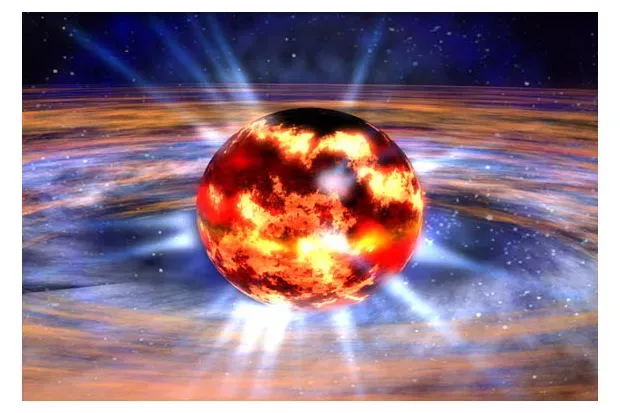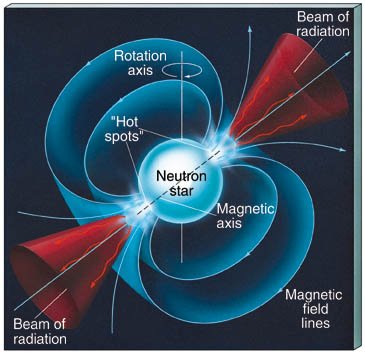
Neutron Stars. Whose mass and gravitational force are unimaginable. It is a creation whose power has amazed everyone. The Neutron Star is made from Big Star. It can also be called dead stars. The future of all the big stars is Neutron Stars. This means that all these giant stars will die at once and become Neutron stars. Let's talk about this Neutron Stars, the wonder of science.
Everything we know has a beginning and an end. A star is full of fuel. And that fuel is called hydrogen. Each star contains a certain amount of hydrogen. The hydrogen is burned and converted to helium and at the same time gives off star brightness.Thus one day this hydrogen fuel of the star runs out.
A star is a huge glowing ball of hot gas. Deep inside its core, hydrogen atoms smash together, forming helium and releasing huge amounts of energy that heats the gas. This is called nuclear fusion, and it's why a star shines. source
Nuclear fusion stops just before a star dies because it runs out of fuel.
Once the supply of Helium in the core is exhausted the core isn't massive enough to start Carbon fusion. At this point fusion stops and the star becomes a white Dwarf source
It is time for the supernova to explode after the star runs out of fuel. A supernova explosion creates a Neutron star. Supernova explosions emit a huge amount of energy into the universe that we can't even imagine.
A supernova is the colossal explosion of a star. Scientists have identified several types of supernova. One type, called a “core-collapse” supernova, occurs in the last stage in the life of massive stars that are at least eight times larger than our Sun. As these stars burn the fuel in their cores, they produce heat. This heat produces pressure that pushes outward against the forces of gravity that pull inward on the star. For most of the life of a star, inward gravity and outward pressure are in balance and the star is stable. But as a star burns through its fuel and begins to cool, the outward forces of pressure drop. When the pressure drops low enough in a massive star, gravity suddenly takes over and the star collapses in just seconds. This collapse produces the explosion we call a supernova. source
Thus a Neutron Star was formed. At the same time the characteristics of the star changed. The star we saw shining in the night sky seemed to be lost somewhere. The brightness and size of a Neutron star and a normal star are not the same. Different differences are created.
The star that was a million times bigger than Earth has become like a city on Earth. As a result of such a large star being so small, its mass density has increased a lot. One teaspoon of Neutron Star has gained the mass equal to a pyramid. What emerges is not so
Neutron stars have a radius on the order of 10 kilometres (6 mi) and a mass of about 1.4 solar masses. source
The gravitational field at a neutron star's surface is about 2×10^11 times stronger than on Earth, at around 2.0×10^12 m/s2.source The temperature of a Newton star rises much higher than before. It is transformed into an extremely hot small sphere. As a result of being so hot, X-rays are emitted from it
The temperature of a neutron star is also imaginary. Its temperature rises a lot from its previous state.
The temperature inside a newly formed neutron star is from around 10^11 to 10^12 kelvins. However, the huge number of neutrinos it emits carry away so much energy that the temperature of an isolated neutron star falls within a few years to around 10^6 kelvins. At this lower temperature, most of the light generated by a neutron star is in X-rays. source
A giant star has become a much smaller star, so its density has increased. We know that there is a lot of space between electrons and protons. If there is an atom equal to a football field then the proton will be like a small marble. So there is a lot of room for any substance to shrink. A substance can be compressed millions of times.
Neutron stars have overall densities of 3.7×10^17 to 5.9×10^17 kg/m3 (2.6×10^14 to 4.1×10^14 times the density of the Sun),[c] which is comparable to the approximate density of an atomic nucleus of 3×10^17 kg/m3. The neutron star's density varies from about 1×10^9 kg/m3 in the crust—increasing with depth—to about 6×10^17 or 8×1017 kg/m3 (denser than an atomic nucleus) deeper inside.[28] A neutron star is so dense that one teaspoon (5 milliliters) of its material would have a mass over 5.5×10^12 kg, about 900 times the mass of the Great Pyramid of Giza. In the enormous gravitational field of a neutron star, that teaspoon of material would weigh 1.1×10^25 N, which is 15 times what the Moon would weigh if it were placed on the surface of the Earth. The entire mass of the Earth at neutron star density would fit into a sphere of 305 m in diameter (the size of the Arecibo Telescope). The pressure increases from 3.2×10^31 to 1.6×10^34 Pa from the inner crust to the center.source

We know that we have a magnetic field around the earth that saves the earth from various accidents. Similarly, a neutron star has a magnetic field that is many times more powerful than the Earth. The magnetic field of a neutron star is very dangerous. If this star comes to the side of the earth in any order, then it will delete the information on all the hard disks of the earth. There is no reason to be afraid because the neutron star is far away from the earth.
In a typical neutron star, the magnetic field is trillions of times that of the Earth's magnetic field; however, in a magnetar, the magnetic field is another 1000 times stronger. In all neutron stars, the crust of the star is locked together with the magnetic field so that any change in one affects the other.source
The distance to the neutron star near our Earth is much greater. This means we are safe
Precise observations made with NASA's Hubble telescope confirm that the interstellar interloper turns out to be the closest neutron star ever seen. Now located 200 light-years away in the southern constellation Corona Australis, it will swing by Earth at a safe distance of 170 light-years in about 300,000 years. source
We know that the earth has a certain rotational speed. The rotation of the earth is 1,000 miles per hour.
Neutron stars can spin as fast as 43,000 times per minute, gradually slowing over time.source
A neutron star is powerful from all sides. We can call it the King of the Stars. What kind of energy and what neutron stars can be understood by observing. Now imagine if you somehow reached the surface of the neutron star. What will happen then? It will mix you with the neutron star and its surface because it has a huge gravitational force. You will become a point of the neutron star which does not even exist. Ha ha. What a powerful neutron star's gravitational force!
This post has links to all the websites from which information has been taken.
Thanks for reading
Best regards

These stars are awesome! Good post, it looks much better with the formatting suggestion I told you. I think the last thing to suggest now is to keep your own content rate higher. I mean, the meaningful content of your post is composed of 1211 words, but more than 52% of them belong to quoted texts! Next time consider making these quotes shorter, so that your own paragraphs stand out and make up the bulk of the post. All this is to make the post qualify better when it comes to curation and everyone who peeks in will learn as well.
I will use own paragraph mostly in my next post. Your support is appreciated. Thank you
Thanks for your contribution to the STEMsocial community. Feel free to join us on discord to get to know the rest of us!
Please consider delegating to the @stemsocial account (85% of the curation rewards are returned).
Thanks for including @stemsocial as a beneficiary, which gives you stronger support.
Congratulations @momins! You have completed the following achievement on the Hive blockchain and have been rewarded with new badge(s):
Your next target is to reach 4250 upvotes.
You can view your badges on your board and compare yourself to others in the Ranking
If you no longer want to receive notifications, reply to this comment with the word
STOPSupport the HiveBuzz project. Vote for our proposal!